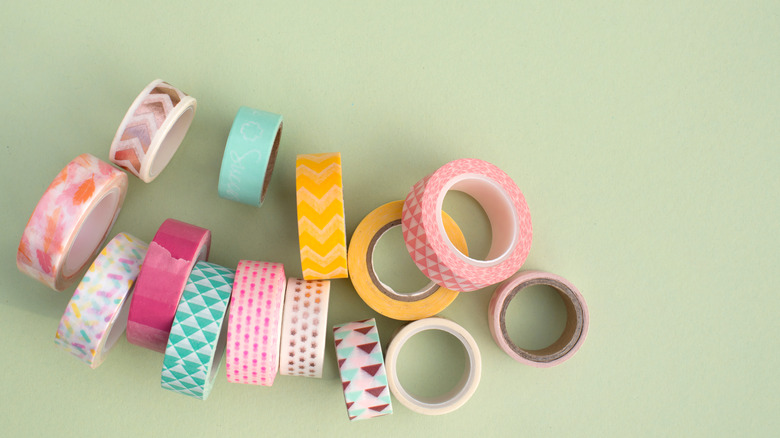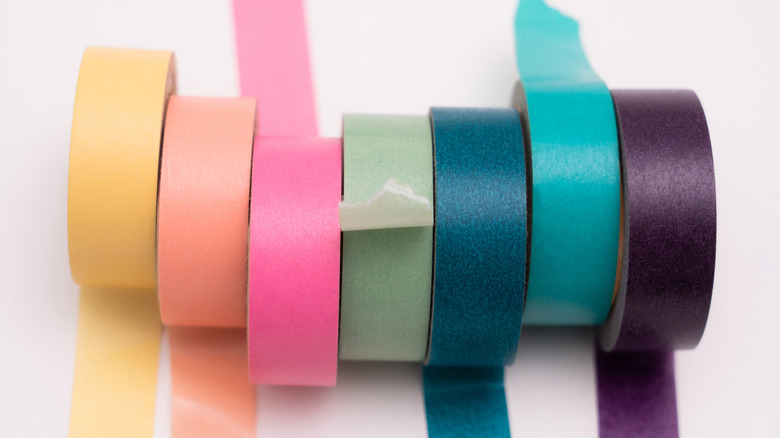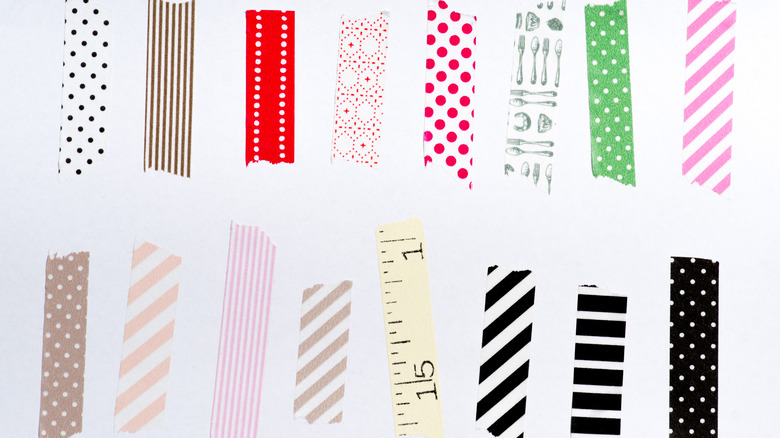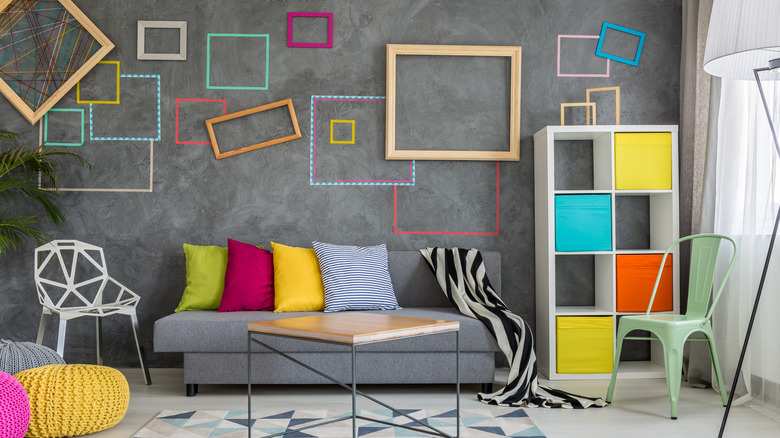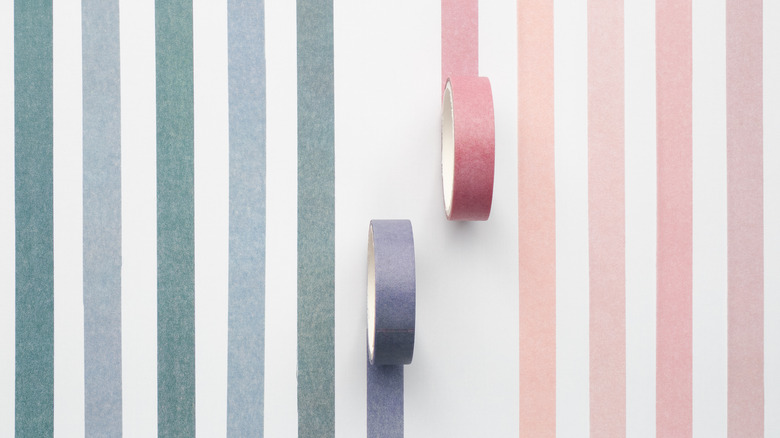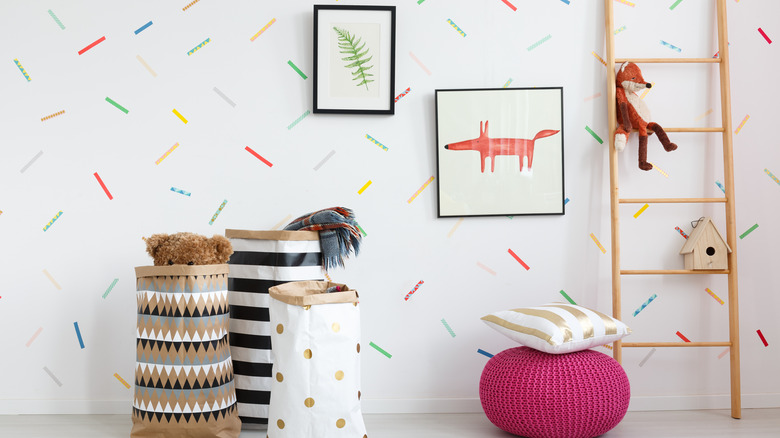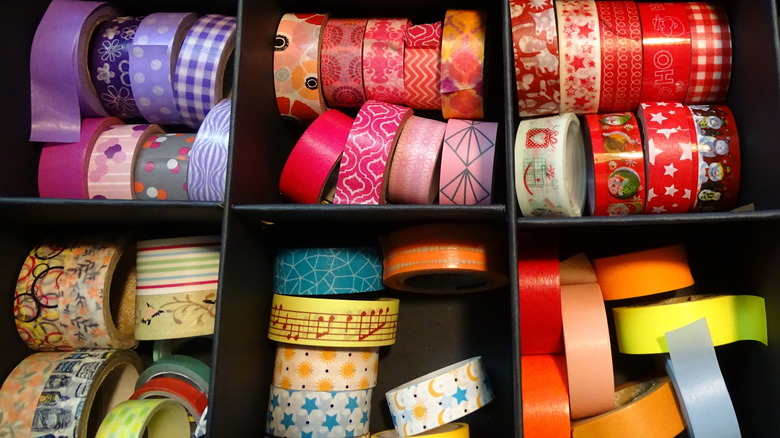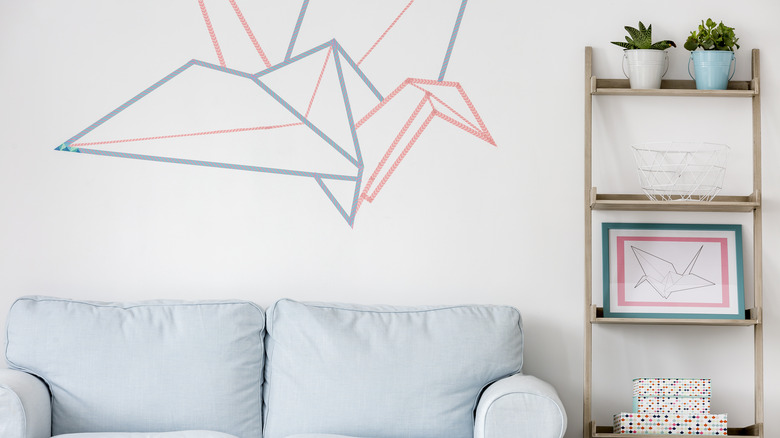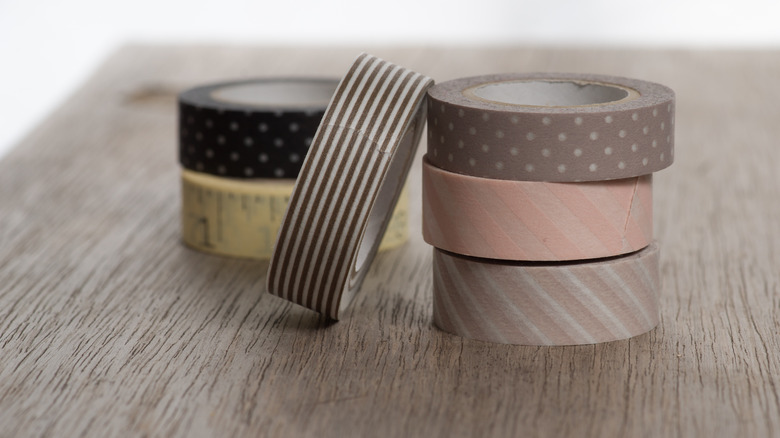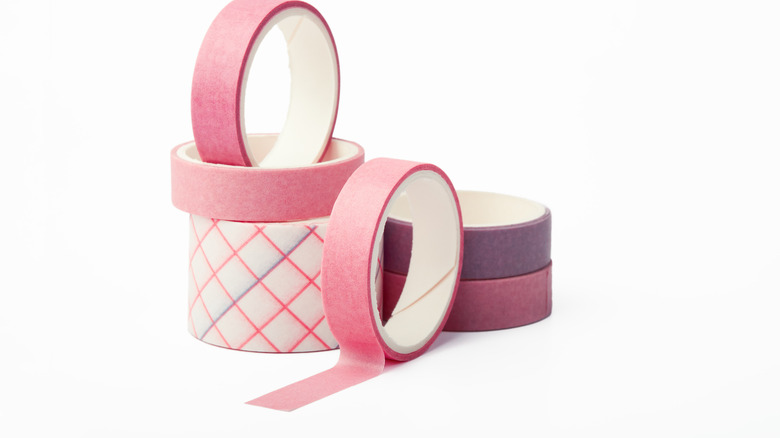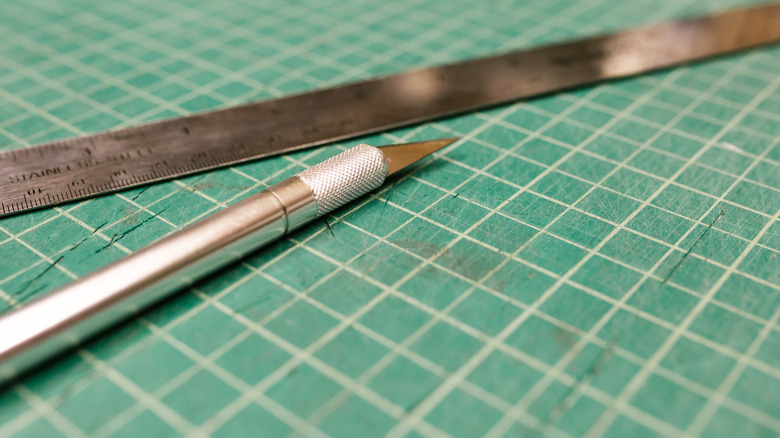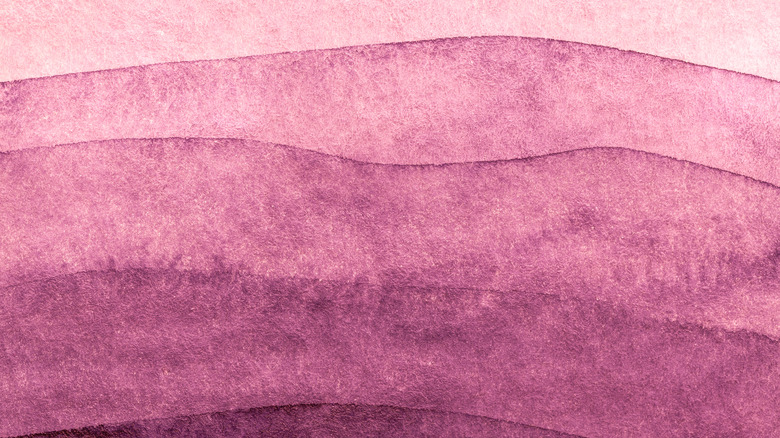How To Use Washi Tape As Decor
Washi tape is flexible and lasting, which has made it a simple, yet fun way to upgrade your decor in almost every room. From picture frames and furniture to doors and windows, they can all be brightened up with a few strips of this colorfully patterned tape. According to The Washi Tape Shop, this DIY staple offers an endless supply of cute patterns, vibrant colors, and intricate designs that can easily be applied and removed from many types of surfaces around your home or office.
If you first heard about washi tape in the scrapbooking aisle at your local craft store a few years ago, you should know it's come a long way since then. As the perfect crafting item grew in popularity, so did users' creativity. Dorm rooms, offices, art projects, classrooms, and more are now overflowing with rolls of washi tape, and simple to complex design projects are popping up. If you wrote the product off as just another roll of tape in the past, you might want to take another look, as almost every color and pattern imaginable is available. Decor doesn't have to be complicated. Follow these tips on how to use washi tape.
What exactly is washi tape?
Masking tape, duct tape, packing tape, painter's tape — isn't it all the same? The short answer is no. Washi tape is a decorative tape made from Japanese rice paper but still functions as tape. Washi tape still comes in a roll and will do the job of most other tapes. However, certain qualities set this tape apart and make it ideal for decorating. A notable characteristic is that the tape has a transparent quality, according to Cute Washi Tape Shop. If you've ever seen Japanese rice paper, then you will note they both have the same flexible, almost see-through attributes.
Washi tape also doesn't leave a residue behind like some other tapes, which makes it ideal for applying and removing, even from paper. The tape can easily be torn with your hands to create an authentic frayed look, which is great for crafting and scrapbooking. It can also be easily cut without getting glue all over your scissors. The transparency makes the tape perfect for creating layered looks, and you can still write on the tape, making it great for labels and more. Washi tape was made with decorating in mind and it continues to be the best option for journaling, scrapbooking, labeling, greeting cards, and much more.
Where did the term and the tape come from?
Washi comes from the words "Japanese paper," as stated by The Washi Tape Shop. The first time washi tape hit the market was in 2008. A masking tape company, Kamoi Kakoshi, began working on something special when a group of customers requested more beautiful tape options. The fun designs and bright colors garnered attention quickly from crafters and designers.
The process of creating washi tape has been refined to near perfection. Using Malaysian rubber that is sliced into delicate strips, the mixture is worked and blended with resin until the material is soft and malleable. The glue adheres to the back of the rice paper tape, and then comes the fun part. The tape is dyed with hundreds of thousands of gorgeous designs, pictures, characters, sayings, and more that inspire artists and creatives worldwide to make something unique. Today, the tape is easily accessible in nearly every craft store, online, and even in some home goods and grocery stores. There seem to be endless ways to use this crafter's tape.
Create a picture frame
Consider DIYing picture frames if you're looking for ways to decorate with washi tape. This simple yet fun project works on nearly any wall surface and can really add a touch of creativity to your space. The best part? You don't have to worry about ruining your walls. This means washi tape picture frames are perfect for rentals, dorm rooms, offices, or other areas that need a budget-friendly spruce, according to Maxwell Tielman.
Have you ever dreamed of a gallery wall in your living room, or wanted to customize your cubicle at work? Don't break the bank on expensive frames for your photos — just create a frame outline with washi tape. A test run is always recommended. Now that washi tape is popular, there are knock-off brands and slightly altered versions that are being passed off as the real deal. This means different residues, sizes, and materials. Place a small strip on your wall near the floor, in a corner, or hidden behind some furniture to test out the glue and residue. If everything works accordingly, you can map out your frames on a sheet of paper. Measure your photos and leave anywhere from 1/2 to 1 1/2 inch of space between the tape and the frame, depending on your taste.
You can keep your frames simple, using neutral colors or solid designs. Or you can get really creative. Try mixing and matching a few different patterns, or layer the frame with two or three strips. You can try squaring the corners or adding a little flair. The idea is that you can be creative, use different colors for each photo, or keep things uniform. There are endless possibilities and this is an awesome way to display your pictures without damaging your walls.
Upgrade your picture frames and other decor
Is your space feeling a little bland? Are plain white or black picture frames filling the walls, or is a particular flower vase too plain or dull? Washi tape can add a spark to almost any surface. According to Bombshell Bling, washi-taped picture frames make customized gifts and seasonal decor an effortless project.
Begin with your patterns and color schemes. Some stores conveniently sell washi tapes that work well together as a set, or you can choose a variety pack that will offer more freedom and creativity. Decide which patterns and colors work best, find your scissors or craft knives, and start cutting. You can cut strips and apply them to the flat surface of the frame, branch out and wrap the frame, or even overlap and layer the tape. Experimenting with the tape is easy because it sticks and resticks so easily. Each frame and surface will be different, but don't be afraid to mess up or start over — part of the fun is finding what works. Add washi tape to notebooks, book covers, posters, tables, desks, chairs, lamps, and whatever else you can think of!
Will washi tape ruin your walls?
Drywall, paint, glass, wood, tile, and more are all safe from true washi tape. According to Paper Mart, the tape is considered a low-tack adhesive and will not pull away paint or damage walls even if the tape has been in the same place for a while. Part of protecting your walls is about how you remove the tape. If you yank the tape from paper or cardboard too quickly then you might notice some tearing, but starting slowly at the edge and pulling away evenly should keep things simple. Textured walls, such as rough wood, brick, stone, and fabric will not be ruined by washi tape either; however, washi tape will likely not stick to these surfaces. It's best to test out different surfaces early on before planning a big DIY project.
However, its low-tack quality means that washi tape is not usually permanent. If you apply washi tape to your walls and the area is low traffic or hardly touched, the tape can remain sticky for years. If you apply the tape to high-traffic areas that are used and cleaned frequently, then you may notice the edges starting to peel away. Keep in mind that drastic temperature changes can also affect the durability of certain glues and tapes. You may notice a change when temperatures drop below 40°F because the glue will begin to harden and have difficulty bonding with the surface it's stuck to (via Tom Brown Inc.).
What else will washi tape stick to?
Washi tape will stick to a number of surfaces with ease — especially smooth flat surfaces — but the best way to know for sure is to test it. According to Little Upgrades, washi tape will stick to glass, jars, vases, picture frames, and even mirrors, although there could be some traces of sticky residue in these scenarios. Paper and cardboard are also great options for washi tape.
Additionally, if you're in school, a teacher, or just like the convenience of dry erase boards, whiteboards, and cork boards, make a note that you can also use washi tape on these surfaces. Washi tape is an excellent option for organizing and labeling. Create rows and columns or label a collection of posters with the convenient and fun tape, or even use it as a name tag. When it comes to wood, don't skip out on washi tape. Smooth or painted wood surfaces work best. Metal is also an ideal material and works much better than some fabrics, styrofoam, and cold surfaces such as outdoor windows, car windows, and water bottles.
Transform your doors or windows
Adding a splash of color to your room is as easy as a few measurements and simple cuts when it comes to washi tape. This hack is excellent for interior doors if you're someone who enjoys a fresh look now and then without putting a strain on your wallet, according to Burlap and Blue. If your door is white, consider several bold colors or a rainbow look. You can also try a variation of a monochrome scheme, with lighter and darker shades of the same color. Try straight, horizontal, vertical, and diagonal lines. You do not need to cover the entire door; adding a few lines to the accents or panels of the door can achieve a polished look that is not too busy.
You can also add a few strips of tape to your windows for a little festive color. Keep in mind that tape does not stick well to surfaces that get too cold, so windows in the cooler months may not be the best surface. A few bright colors in the summer can liven up your space and create an exciting seasonal look. And if you're feeling extra ambitious, try creating a picture or mural on your wall with the straight lines of washi tape.
How to mix and match patterns like a professional
One of the great benefits of washi tape is the range of colors and patterns available. The transparent aspect makes layering the tape easy, giving you ample opportunity to mix and match. You don't have to be an expert designer to mix prints successfully; follow these tips to create the perfect look. According to Bella Ella Boutique, stripes are an excellent starting point because the design is so simple that it functions as a neutral. Mixing different-sized stripes can work if you stay within the same color scheme because patterns need to have a unifying element that ties everything together.
Try to avoid getting too busy, which means having more than one bold pattern likely won't work. Consider pairing thick, neutral-colored stripes with a colorful floral or intricate design. Another pairing that works great is opposites. For small polka dots, look for wider dots to create contrast. Starting with bright colors and using complementary tones, add a muted shade to go with it. Follow these tips, and you'll be mixing patterns like an expert. It's important to have fun and try new, unexpected things — you'll be surprised by what works!
How to make washi tape last longer
Washi tape is perfect for rentals and dorm rooms, but what about when you want your project to be more permanent? Can you make washi tape last longer, even in high-traffic areas that are touched and cleaned frequently? Because the adhesive on washi tape is low tack, you'll need to cover the tape with some other type of glue or sealant that is stronger and will last if you want a permanent look, according to Naptime Crafts.
Mod Podge and other decoupage products are often the first choices when making washi tape more permanent. This simple glue-like mixture can be easily painted over the tape, and it dries clear, so you don't lose any of the beauty of the tape underneath. However, most decoupages are not truly permanent. A layer of Mod Podge is perfect for greeting cards, paper products, and more, but this clear finish is often finicky when it comes to hot and cold surfaces. For example, if you decorate a mug with washi tape and cover it with decoupage, hot liquids and the dishwasher would likely cause the glue to peel away quickly. Carefully consider where and how your decor will be used and plan accordingly.
Sealant or varnish are much better choices if you want your washi tape to make it for the long haul. A clear coat over washi tape on doors, picture frames, desks, or lamps will prevent edges from peeling, colors from fading, and damage from cleaning products.
Be precise, use an X-Acto knife
There's no need for a special washi tape cutter, but if you are a perfectionist or working on a decor project, you may want something more precise than just tearing washi tape. In fact, there are several ways to precisely cut washi tape, according to Bellewood Cottage. First of all, X-Acto knives or craft knives are extremely sharp, which means you should be cautious from start to finish. These tools will give you excellent straight lines that can give your decor a finished and professional look. They are perfect for corners, small cuts, and spaces too tight for scissors. Be sure you use a piece of cardboard or a safety mat on your workspace to prevent damaging your table.
A few other ways to achieve a straight edge are scissors if you cut carefully. You can also use a straight edge, such as a ruler, and pull up to tear the tape. If you don't need a straight edge or like the frayed imperfect look, you can simply tear washi tape with your hands.
Make your own washi tape
If you are feeling extra creative, you can make your own washi tape with a few basic materials. Channel your style and creative talent into a useful and beautiful crafting tape with these tips. The first thing you'll need to do is decide how your tape will stick, which means choosing an adhesive, as noted by Artsy Fartsy Life. Unless you've mastered the science behind mixing glues and adhesives, you should consider some premade choices. A few options are double-sided sticker paper, one-sided sticker paper (you'll need to use Mod Podge or some other glue between the paper and your design), or a sticker machine that you can print and then cut into strips.
Traditional washi tape is made from Japanese rice paper, but there are a few other options when creating your own. Rice paper, tissue paper, tracing paper, printer paper, wrapping paper, and others can work as well. Thin, flexible, and even slightly transparent options yield the best results.
Now is where you can get really creative. Wrapping paper and other tissue paper may have their own designs, but you can also draw or paint your own patterns as well. Once your design is complete, lay the sticker paper and your designs flat against each other and smooth the two layers out evenly. A paper cutter or a ruler will help you cut your designs into straight lines. Most washi tape is less than 1 inch wide, but since this is your project, you can cut it to the width of your choosing. Use an X-Acto knife, craft knife, or a sharp pair of scissors to easily cut through both layers into long strips that can be used for your decor and other projects.
